practicalguideto00unse_0
Create successful ePaper yourself
Turn your PDF publications into a flip-book with our unique Google optimized e-Paper software.
42<br />
The Minster Library is the only other portion of the<br />
palace existing ;<br />
it was the chapel, and is a most interesting specimen<br />
of Early English architecture. Since 1808 it has been<br />
restored, and now contains upwards of 8,000 volumes and<br />
MSS., formerly kept in a small building attached to the south<br />
-side of the Minster. This present collection, it must be understood,<br />
is of modern formation. The ancient one, which was<br />
established by Archbishop Egbert (731 to 767) was most valuable,<br />
and was entrusted to the care of the learned Alcuin, in<br />
whose time students came from afar to avail themselves of the<br />
treasures it contained. This was unfortunately consimied by<br />
fire in 1069. The nucleus of the present one was formed in<br />
the seventeenth century by the presentation of 3,000 volumes<br />
by the widow of Archbishop Mathew. It has since been<br />
enriched by gifts from Lord Fairfax and others, and by the<br />
library of Dr. Fothergill, the non-juring minister of Skipwith.<br />
It is a commodious room, lighted at the west end by<br />
five lancet windows, filled with stained glass.<br />
Amongst the antiquarian and literary treasures it contains<br />
are : a copy of the Second Edition of Erasmus' New Testament,<br />
in Greek and Latin, two folio volumes, printed on<br />
vellum, by Frobenius at Basle.<br />
A MS. copy of Wickliffe's New Testament, on vellum, with<br />
autograph of Queen Elizabeth.<br />
Three MS. copies of the Vulgate, on vellum, of the time<br />
of Henry III. and Edward I.<br />
Also a number of valuable books printed by Caxton,<br />
Wynkyn de Worde, and Pynson.<br />
It is open to visitors free, on Mondays and Wednesdays,<br />
from 11 a.m. to 1 p.m., and on Saturdays from 2 till<br />
4 p.m.<br />
Adjoining is the Deanery, a large and handsome house,<br />
in the Tudor style, built of stone in 1827. The old<br />
Deanery was on the south-east side of the Minster Yard,<br />
the site now occupied by the School of Design.<br />
To the north-west is The Canons' Eesidence, also in the<br />
Tudor style, and intended for the accommodation of the four<br />
residentiary Canons during their quarterly term of office.<br />
York Probate Kegistry of the High Court of Justice, a<br />
semi-Gothic building, nearly opposite the south entrance to<br />
the Minster. Here are kept all wills for the North and East















